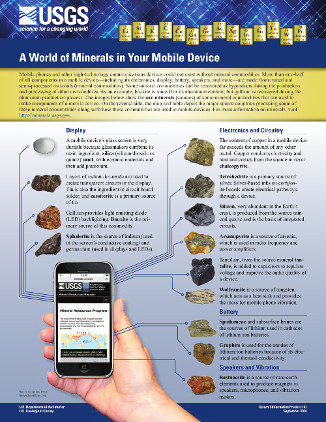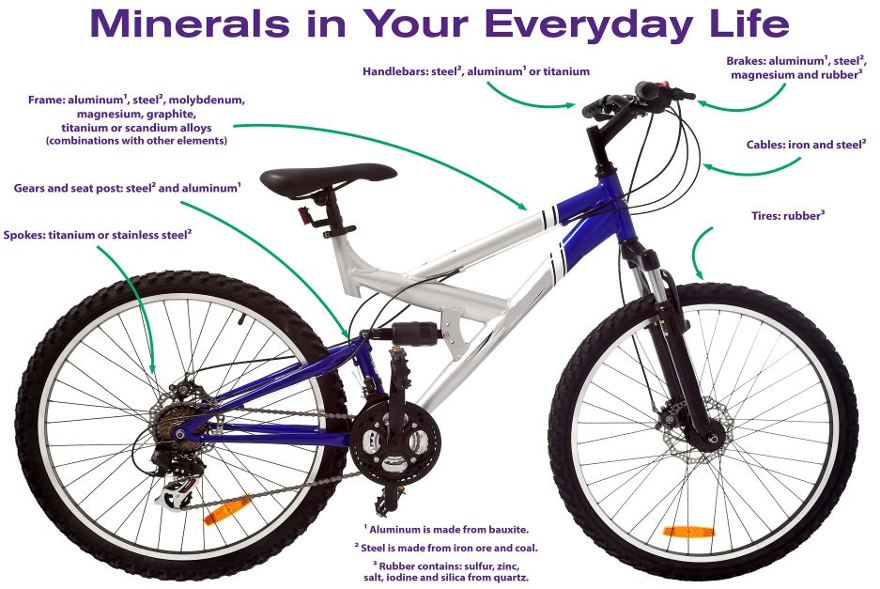- Why Mining Matters
- Jobs
- Safety
- Environment & Operations
- FAQ
- Links
- Fun Stuff
Minerals in your daily life
Minerals contribute to everything in our daily lives.
Here are some examples:
Mobile Phones | Bicycles | Soccer | Toothpaste | Green Tech | Solar Panels | Wind Turbines | Your Body | Your House | Clocks & Watches | Halloween | Paper | Toilets | Fireworks | Paint
Mobile Phones
Mobile phones and other electronic devices could not exist without minerals.
Most electronics include dozens of minerals.
To the right (in the image - see larger version here ) are some examples of minerals in mobile phones.
Other examples of minerals and metals in mobile phones include:
- Gold (circuitry).
- Magnesium compounds (phone case).
- Palladium (circuitry).
- Platinum (circuitry).
- Tungsten (circuitry).
SOCCER
Minerals even help make sports and other recreational activities possible. Check out how mining contributes to soccer: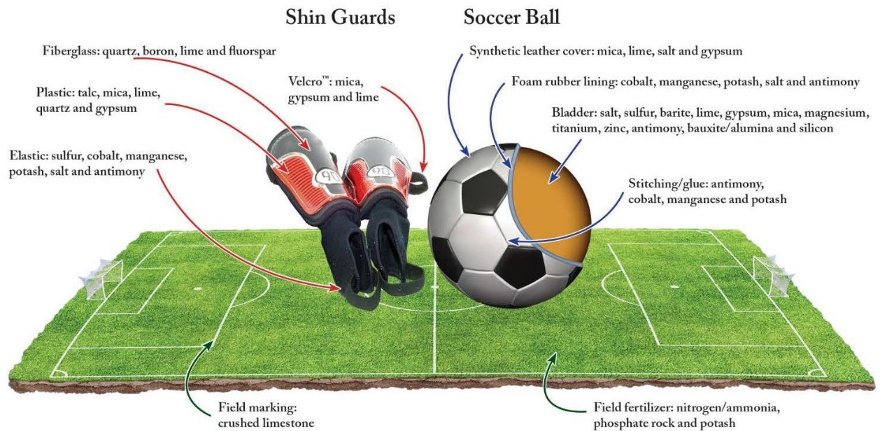
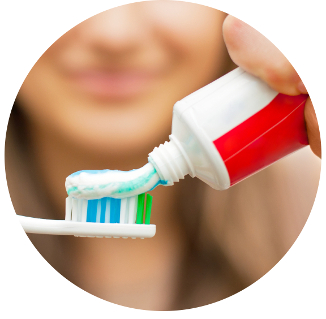
TOOTHPASTE
Yep, there is rock in your toothpaste!
Toothpaste usually contains powdered limestone which is used as an abrasive to clean off plaque.
GREEN TECH
We all want to reduce society’s environmental footprint. In our daily lives, we increasingly recycle, try to reduce our energy consumption and adopt new technologies that reduce our impact.
New “green” products and technological advancements are only possible because of the materials we take from the ground.
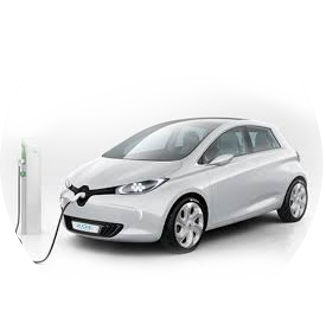
Hybrid Vehicles
Hybrid vehicles include the following minerals:
- Bauxite (aluminum)
- Cadmium (batteries)
- Chromite (chromium)
- Coal (by-product coke is used to make steel)
- Cobalt (alloy; batteries)
- Copper (wiring)
- Gold (circuitry)
- Iron ore (steel)
- Lead (batteries)
- Lithium (batteries)
- Manganese (steel alloy)
- Molybdenum (steel alloy)
- Nickel (batteries; alloy)
- Platinum (circuitry)
- Rare Earth Oxides - Lanthanum (batteries), Neodymium (electric motors)
- Silica (silicon)
- Sulfur (chemical solutions)
- Tungsten (wiring)
- Vanadium (alloy)
- Zinc (galvanizing)
Fast Facts:
- Hybrid cars use twice as much copper as non-hybrid cars. Copper wiring is essential to making hybrid vehicles work.
- The glass in vehicle windows contain the minerals trona and feldspar.
- Carpeting contains boron and limestone.
- Steel-belted tires contain mica, sulfur, beryllium, cobalt, and zinc and copper
SOLAR PANELS
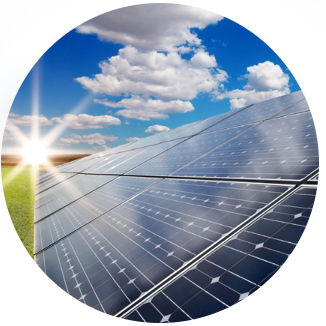
Solar panels include the following minerals:
- Arsenic (gallium-arsenide semiconductor chips)
- Bauxite (aluminum)
- Boron Minerals (semiconductor chips)
- Cadmium (thin film solar cells)
- Coal (by-product coke is used to make steel)
- Copper (wiring; thin film solar cells)
- Gallium (solar cells)
- Indium (solar cells)
- Iron ore (steel)
- Molybdenum (photovoltaic cells)
- Lead (batteries)
- Phosphate rock (phosphorous)
- Selenium (solar cells)
- Silica (solar cells)
- Tellurium (solar cells)
- Titanium dioxide (solar panels)
Fast Facts
- Even though the sun is 93 million miles from earth, it takes less than 10 minutes for the light of the Sun to reach the Earth.
- Spacecraft and space stations such as the International Space Station (ISS) often use solar panels to generate power.
- While solar power is becoming more efficient and its use is increasing, it currently only provides a small fraction of the world’s energy supply.
- When the sun isn't shining, other types of power sources, such as Nova Scotia’s coal plants, must be used to make electricity.
WIND TURBINES
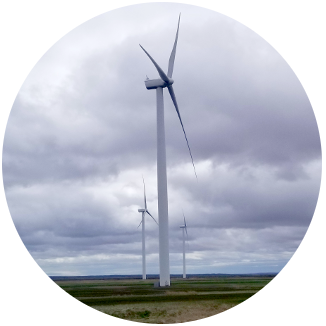
Wind turbines include the following minerals:
- Aggregates and Crushed Stone (for concrete)
- Bauxite (aluminum)
- Clay and Shale (for cement)
- Coal (by-product coke is used to make steel)
- Cobalt (magnets)
- Copper (wiring)
- Gypsum (for cement)
- Iron ore (steel)
- Limestone (for cement)
- Molybdenum (alloy in steel)
- Rare Earths (magnets; batteries)
- Zinc (galvanizing)
- Sand and Gravel (for cement and concrete)
Fast Facts:
- Wind turbine foundations may contain over a thousand tons of concrete and rebar. Dimensions are often between 30-50 feet across and 6-30 feet deep. The average tower height is 229 feet, 8 inches. Shafts are sometimes driven down farther to help anchor it.
- A strong foundation is critical to stabilizing the immense weight of the turbine assembly and aggregates are necessary to make the foundation’s cement and concrete. Depending on the model, industrial wind turbines can weigh between 164-334 tons, or more.
- Like old fashioned windmills, today's wind turbines use blades to collect the kinetic energy of the wind. The wind flows over the blades creating lift, like the effect on airplane wings, which causes them to turn. The blades are connected to a drive shaft that turns an electric generator to produce electricity.
- When the wind isn't blowing, other types of power sources, such as Nova Scotia’s coal plants, must be used to make electricity.
YOUR BODY
Just like vitamins, minerals help your body grow, develop and stay healthy. Minerals originate in the earth and cannot be made by living organisms. However, plants absorb minerals from soil and humans get minerals from eating plants and animals or from drinking water.
Mineral supplements can also be made from mined minerals to ensure people get the minerals they need.
Here are some examples of minerals in your diet that help keep your body healthy:
Calcium, which you consume in foods like milk and broccoli, helps make your bones and teeth strong. Calcium makes up 920 to 1200 grams of adult body weight, with 99% of it contained in bones and teeth.
Iron, from foods such as spinach and beef, is an important component of hemoglobin, the substance in red blood cells that carries oxygen from your lungs throughout your body.
Zinc, from foods like beef, chicken and cereal, helps your immune system fight off invading bacteria and viruses. Your body also needs zinc to make proteins and DNA, the genetic material in all cells. Zinc also helps wounds heal and is important for proper senses of taste and smell. Zinc supplements, made from mined zinc, save hundreds of thousands of lives each year. Nearly a third of the world’s population suffers from zinc-related malnutrition so mining companies and UNICEF work together to provide millions of zinc supplements to children in places like Africa.
Magnesium is in spinach, kale, bananas, raspberries, nuts and peas. Magnesium helps regulate muscle and nerve function, blood sugar levels, and blood pressure. It also helps make protein, bone, and DNA.
Sodium, or salt, is essential to good health. It's needed to transmit nerve impulses, contract and relax muscle fibers (including those in the heart and blood vessels), and maintain a proper fluid balance.
Copper is an essential nutrient for the body. Together with iron, it enables the body to form red blood cells. It helps maintain healthy bones, blood vessels, nerves, and immune function, and it contributes to iron absorption. Copper is in leafy greens, including turnip greens, spinach, Swiss chard and kale. Asparagus and summer squash are two other excellent vegetable sources of copper, as are whole grains, nuts, and seeds.
Check out all the elements that are in human bodies, including many minerals: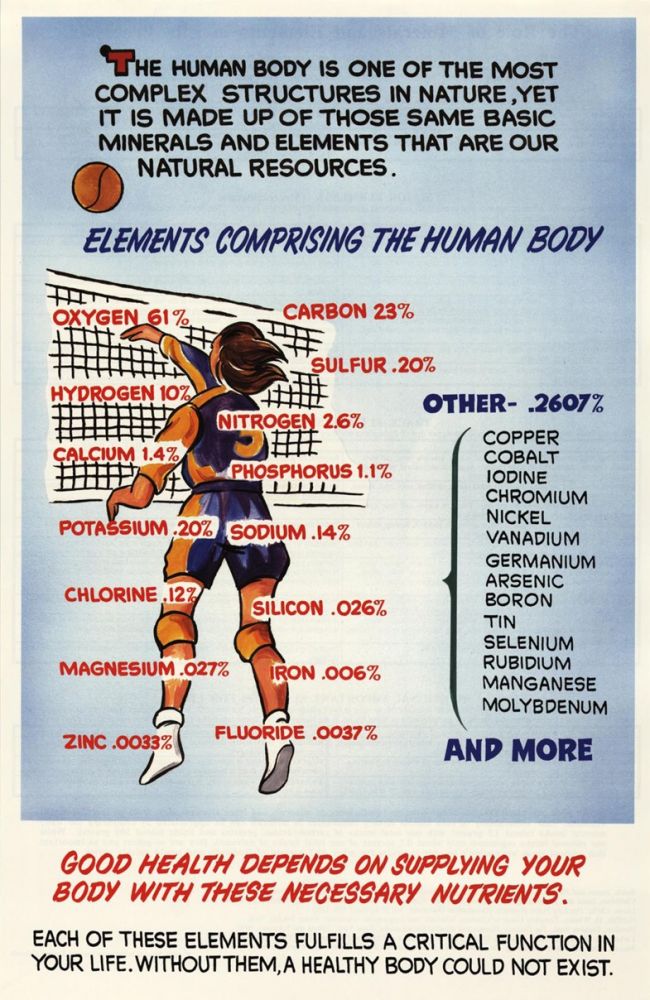
Source: https://mineralseducationcoalition.org/
YOUR HOUSE
Aggregate is the word used to describe sand, rocks, gravel, crushed stone and shale that are used in construction. Aggregate is used virtually everywhere – in all buildings and infrastructure, including homes, roads, schools and hospitals.
Each person uses 10 to 15 tonnes of aggregate each year. That’s one tandem truckload per Nova Scotian. For example, building a single family home requires about 160 tonnes of gravel (about 11 truckloads).
The infographic below illustrates the many ways aggregates contribute to your home: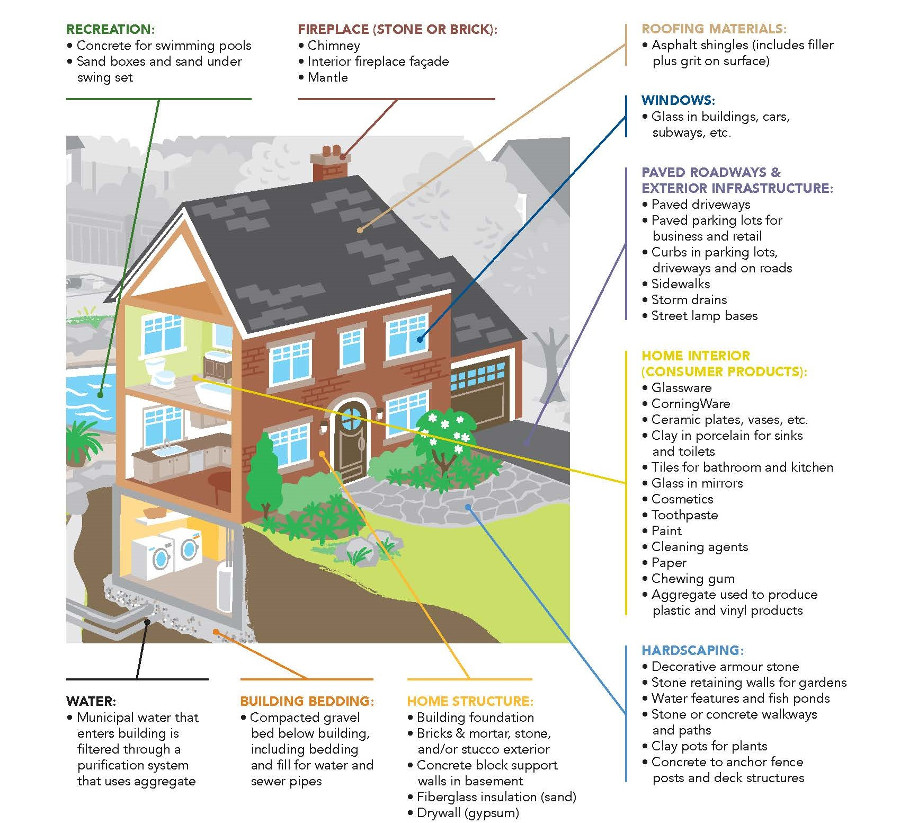
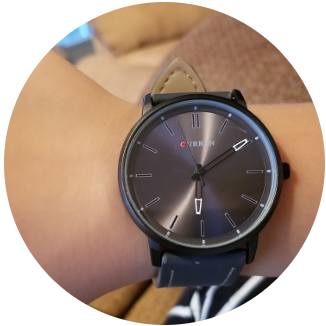
CLOCKS & WATCHES
Clocks and watches contain several minerals, including quartz crystals. The battery sends electricity to the quartz which makes it oscillate at a precise rate: 32,768 times per second. This tracks the time like the pendulum on a grandfather clock does.
Atomic clocks, the world's most accurate, use the natural oscillation of the cesium atom as their timekeeper. Cesium atoms oscillate exactly 9,192,631,770 times a second, driving a clock that is accurate to within a millionth of a second per year. Cesium is a metal.

HALLOWEEN
Minerals help make Halloween scary!
Makeup worn by trick or treaters contains minerals such as zinc, titanium and talc, all of which we have in Nova Scotia.

PAPER
We all know trees make paper but so do minerals. Paper contains kaolin, talc, calcium carbonate and bentonite. The use of minerals in paper production increases the speed and quality of manufacturing.
The final characteristics of the paper (strength, whiteness, gloss, ink retention, etc.) are largely determined by the blend of minerals used. For example, glossy paper has a thin coating of minerals on it to give it that glossy look and feel.
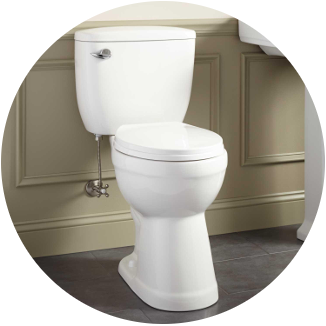
TOILETS
Uh, this is pretty important…. Minerals make toilets possible!
For example, feldspar is a key ingredient in porcelain, which is what toilets are made of. Feldspar makes up over 50% of Earth’s crust.
Chromite is in the plumbing fixtures. Chromite is a big part of steel and it is one of the first minerals to separate from magma as it is cooling.
Copper is in the tubing. Copper was first discovered in Nova Scotia in 1825 and there have been several copper mines in the province over the years.
Seriously, what would your life be like without mining?!

FIREWORKS
Minerals make fireworks!
For example, copper makes blue fireworks. Strontium makes red. Titanium makes white. Sodium makes yellow.
Mixing the minerals makes additional colours (i.e. mixing copper and strontium creates purple).
Gold sparks are made with iron filings and charcoal.
Flashes and bangs? Aluminum powder.
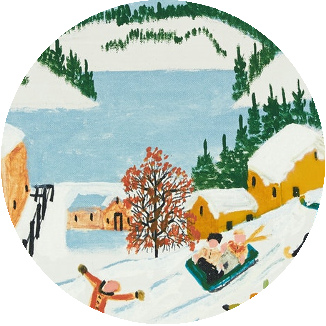
PAINT
Minerals have been used in paints since prehistoric times to give them colour. Minerals are crushed into powder and mixed with a binder, such as oil or acrylic today and animal fat in centuries past. The binder holds the mineral powder together and allows the paint to be spread. It also binds it to the canvass or whatever you are painting on. Titanium makes white, iron makes red, coal makes black, etc.
From cave paintings that are thousands of years old to the 21st century, minerals have made paint possible!













































